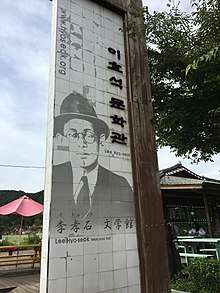Lee Hyo-seok
Lee Hyo-seok (Korean: 이효석, February 23, 1907 – May 5, 1942) was a Korean writer.[1]
| Born | February 23, 1907 |
|---|---|
| Died | May 25, 1942 (aged 35) |
| Language | Korean |
| Nationality | Korean |
| Korean name | |
| Hangul | |
| Hanja | |
| Revised Romanization | I Hyoseok |
| McCune–Reischauer | I Hyosŏk |
Life
Lee Hyo-seok, who wrote under the pen-name 'Gasan' (가산) was born February 23, 1907 in Pyeongchang, Gangwon-do. Lee was deeply impressed by Chekhov and Thomas Mann and graduated first in his class at the Gyeongseong Je-il Academy.[2] Lee enrolled in Gyeongseong Imperial University in 1925, the same year, his poem “Spring” (Bom) was published in the Daily News(매일신보). At Gyeongsong Lee published his poetry in a student magazine (Clear and Cool or Cheongnyang), and in a literary coterie journal (Friends in Literature or 무누).[2] He graduated in 1930 with a degree in English Literature and worked for a short stint in the censorship section of the Police Affairs Division of the Japanese Government-General. Lee then moved to his wife's hometown of Gyeongseong, Hamgyeongbuk-do, where he worked as an English teacher. In 1934 he began teaching at Soongsil University in Pyeongyang. He died in May 1942 at the age of 35.[3]
Work
Lee wrote more than 70 pieces of fiction and first attracted attention of the literary world in 1928 when his story City and Ghost (Dosi-wa yuryeong) was published in Light of Korea (Joseon jigwang). Lee published many other works including Unanticipated Meeting (Giu), Shattered Red Lantern (Kkaetteuryeojineun hongdeung) and At Sea Near Russia (Noryeong geunhae), all of which reflected his socialist sympathies.[2] Lee's work was self-consciously political and frequently focused on the lives of unfortunate women forced into prostitution, often combining his political message with explorations of sexuality.[4] In 1933, however, coincident with increased pressure from Japanese occupiers that literature not be political Lee helped found the Group of Nine (Guin hoe), and abandoned political literature in favor of more aesthetic approaches.[2] The Group of Nine included Jung Jiyong, Yi Sang, Kim Girim, Lee Taejun all of whom influenced Lee.[2] Lee continued to be concerned with eroticism, but his focus also turned largely to nature. In his story Pig, Lee writes of a man who raises a sow, with the intent of building a pig farm, but superimposes human sexuality over the rutting of the pigs. In Bunnyeo, Lee explored a sexually wanton character. When Buckwheat Flowers Bloom, Lee's most famous story, follows the story of an itinerant trader and the love he feels for a younger man, his son as the result of a one-night stand.
Lee Hyo-seok Village and Festival
When Buckwheat Blossoms Bloom is set in Lee's hometown Bongpyeong-myeon, Pyeongchang-gun) and the area is still famous for its buckwheat production. The town is surrounded by a ring of 1,500 meter tall mountains and the Lee Hyo-seok Memorial Hall is located in the town inside the Lee Hyo-seok Culture Village which, in 1990 was designated ‘the first national cultural village,’ by the Ministry of Culture and Tourism. The site features is a small river, a water mill house, a small thatched house and the inevitable miniature dioramas of the novel.[5]
At the end of August to early September (the date differs each year) the annual Lee Hyo-seok Cultural Festival takes place. The event is buckwheat themed and the events include an essay contest, a photo contest, a colorful parade and a variety of films and performances related to Buckwheat Blossoms. There is also an abundance of buckwheat based food, including excellent noodles and pancakes.[5]

Works in Translation
- The Buckwheat Season (메밀꽃 필 무렵)
- KHI HOA KiẾU MẠCH NỚ (메밀꽃 필 무렵)
- Cuando florece el alforfón (이효석 단편선)
- Flower Dust (first chapter only)
| Wikisource has original text related to this article: |
Works in Korean (Partial)
- Pollen (화분)
- The Boundless Blue Sky (벽공문한)
- Collected Works of Hyo-seok (효석전집)
References
- "이효석" biographical PDF available at LTI Korea Library or online at: http://klti.or.kr/ke_04_03_011.do# Archived 2013-09-21 at the Wayback Machine
- "KLTI Author Database: "Archived copy". Archived from the original on 2011-07-10. Retrieved 2011-08-02.CS1 maint: archived copy as title (link)
- Who's Who in Korean Literature, Korea Culture and Arts Foundation, p. 496
- Who's Who in Korean Literature, Korea Culture and Arts Foundation, p. 497
- KTLIT, Lee Hyo-seok (Buckwheat Blossoms) Memorial Village and Festival, http://www.ktlit.com/korean-literature/lee-hyo-seok-buckwheat-blossoms-memorial-village-and-festival
External links
- (in Korean) Lee Hyo-Seok Memorial Hall (이효석 문학관)